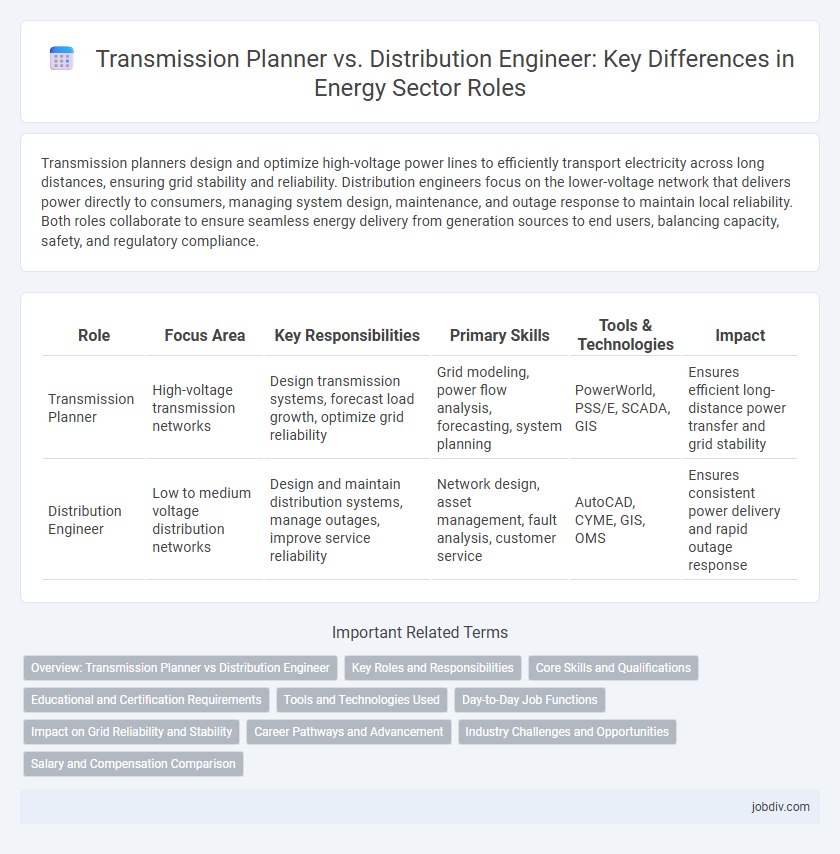Transmission planners design and optimize high-voltage power lines to efficiently transport electricity across long distances, ensuring grid stability and reliability. Distribution engineers focus on the lower-voltage network that delivers power directly to consumers, managing system design, maintenance, and outage response to maintain local reliability. Both roles collaborate to ensure seamless energy delivery from generation sources to end users, balancing capacity, safety, and regulatory compliance.
Table of Comparison
| Role | Focus Area | Key Responsibilities | Primary Skills | Tools & Technologies | Impact |
|---|---|---|---|---|---|
| Transmission Planner | High-voltage transmission networks | Design transmission systems, forecast load growth, optimize grid reliability | Grid modeling, power flow analysis, forecasting, system planning | PowerWorld, PSS/E, SCADA, GIS | Ensures efficient long-distance power transfer and grid stability |
| Distribution Engineer | Low to medium voltage distribution networks | Design and maintain distribution systems, manage outages, improve service reliability | Network design, asset management, fault analysis, customer service | AutoCAD, CYME, GIS, OMS | Ensures consistent power delivery and rapid outage response |
Overview: Transmission Planner vs Distribution Engineer
Transmission Planners design and optimize high-voltage power grid systems to ensure efficient, large-scale electricity transfer across regions, focusing on long-distance energy flow and grid reliability. Distribution Engineers manage the lower-voltage network that delivers electricity directly to consumers, addressing local load balancing, outage response, and infrastructure maintenance. Both roles require expertise in grid modeling, but Transmission Planners emphasize system-wide capacity and expansion, while Distribution Engineers focus on localized service quality and asset management.
Key Roles and Responsibilities
Transmission Planners design and develop high-voltage power lines and substations to ensure efficient grid reliability and capacity for long-distance electricity transfer. Distribution Engineers focus on the operation, maintenance, and improvement of low-voltage networks that deliver electricity directly to consumers, emphasizing safety, load balancing, and outage management. Both roles require collaboration to optimize grid performance and support sustainable energy integration.
Core Skills and Qualifications
Transmission Planners specialize in high-voltage grid design, load flow analysis, and system reliability assessments, requiring expertise in power system modeling, regulatory compliance, and project management. Distribution Engineers focus on medium to low-voltage networks, emphasizing circuit design, fault analysis, and maintenance scheduling, with skills in SCADA systems and customer service integration. Both roles demand strong analytical abilities, proficiency in advanced simulation tools, and a solid understanding of electrical codes and standards.
Educational and Certification Requirements
Transmission Planners typically require a bachelor's degree in electrical engineering, power systems, or a related field, with many employers favoring candidates who hold professional certifications such as the Professional Engineer (PE) license or Certified Energy Manager (CEM) credential. Distribution Engineers generally need a degree in electrical or civil engineering and often pursue certifications like the Engineer-in-Training (EIT) or licenses specific to utility companies and grid operations. Both roles emphasize expertise in power system analysis, but Transmission Planners focus more on grid reliability and capacity, while Distribution Engineers specialize in network design and field implementation, reflected in their distinct educational pathways and certification priorities.
Tools and Technologies Used
Transmission Planners utilize advanced software like PSS(r)E and PowerWorld Simulator for load flow analysis and grid stability assessments, alongside Geographic Information Systems (GIS) to optimize long-distance power delivery routes. Distribution Engineers rely on Distribution Management Systems (DMS), outage management software, and smart grid technologies such as Advanced Metering Infrastructure (AMI) to enhance local grid reliability and real-time monitoring. Both roles incorporate SCADA systems for remote control and data acquisition, but the tools are tailored to the scale and complexity of transmission versus distribution networks.
Day-to-Day Job Functions
Transmission Planners analyze and design high-voltage power grid systems to ensure reliable long-distance electricity flow, coordinating system upgrades and load forecasts. Distribution Engineers focus on the lower-voltage network that delivers electricity to end-users, managing outage response, system maintenance, and distribution grid optimization. Both roles require close collaboration to maintain grid stability and effectively support energy demand across transmission and distribution levels.
Impact on Grid Reliability and Stability
Transmission planners optimize long-distance power flow by designing high-voltage networks that minimize congestion and outage risks, directly enhancing grid reliability and stability on a macro scale. Distribution engineers focus on local grid operations, managing load balancing, fault detection, and rapid restoration to ensure consistent power delivery to end-users, which stabilizes the distribution network. Both roles are critical: transmission planners prevent large-scale blackouts by maintaining backbone infrastructure, while distribution engineers address localized disruptions to sustain uninterrupted electrical service.
Career Pathways and Advancement
Transmission Planners specialize in designing and optimizing high-voltage power grid systems, focusing on large-scale infrastructure projects that ensure efficient energy transfer across regions. Distribution Engineers concentrate on the lower-voltage networks that deliver electricity to end-users, emphasizing reliability and maintenance of localized energy delivery systems. Career advancement for Transmission Planners often leads to senior roles in grid management and regional energy coordination, while Distribution Engineers may progress into leadership positions overseeing smart grid implementation and utility operations.
Industry Challenges and Opportunities
Transmission planners address the complexities of long-distance energy transport by optimizing grid stability and integrating renewable sources amid aging infrastructure and regulatory pressures. Distribution engineers focus on enhancing local reliability and smart grid technologies while managing demand fluctuations and grid decentralization. Both roles present opportunities to innovate through advanced analytics and digitalization to support a resilient, efficient energy system.
Salary and Compensation Comparison
Transmission Planners typically earn higher salaries than Distribution Engineers due to the complexity and scale of managing high-voltage power systems, with median annual wages around $85,000 to $110,000 compared to $70,000 to $95,000 for Distribution Engineers. Compensation packages for Transmission Planners often include bonuses and incentives linked to project milestones and grid reliability improvements, whereas Distribution Engineers may receive benefits focused on fieldwork allowances and technical certifications. Geographic location and industry sector also significantly influence salary variations in both roles within the energy transmission and distribution fields.
Transmission Planner vs Distribution Engineer Infographic

 jobdiv.com
jobdiv.com